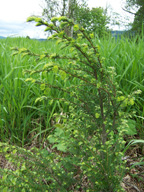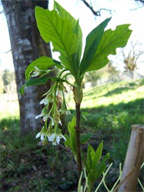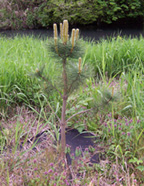
|
|
|
|
|
|
|
|
Some common species found on our sites. . .
Big Leaf Maple, Acer macrophyllum
Tree. Leaves opposite, 5-lobed maple leaves, dark green above, paler below. Flowers are greenish-yellow, 3 mm across; numerous on short stalks in a hanging cylindrical cluster; appear with or before leaves. Bark reddish on young tree, branches opposite and making a strong V-shape.
Big Leaf Maple (Acer macrophyllum)
Black Cottonwood, Populus balsamifera ssp . trichocarpa
Tree. Leaves alternate, thick, oval, but heart-shaped at base, pointed at tip. Buds are red, pointed and sticky. Flowers are in catkins, male and female flowers on separate plants.
Black Cottonwood (Populus trichocarpa)
Creek Dogwood, Cornus serica
Shrub. Leaves opposite, oval, 5-10 cm long, mostly sharp-pointed with 5-7 prominent parallel veins that converge at leaf tips. Flowers are white to greenish, small, 4 petals and stamens, numerous in dense flat-topped terminal clusters.
Creek Dogwood (Cornus sericea)
Douglas spiraea, Spiraea douglasii
Shrub. Leaves alternate, oblong to oval, 4-10 cm long, toothed above the middle, dark green above, paler and often grey-woolly beneath. Flowers are pink to deep rose, about 5 mm across); numerous, in long, narrow, compact terminal cluster several times longer than wide. Young growth is reddish-brown and woolly.
Douglas Spiraea (Spiraea douglasii)
Grand Fir, Abies grandis
Tree. Flattened needles, about 3/4 to 2 inches long, dark yellow-green above with 2 white bands (stomata lines) below. Cones are 2 to 4 inches long, barrel-shaped, and borne upright on the twig; cone scales are deciduous, falling from the cone as seeds ripen; green to purplish green when mature. A large evergreen, commonly 150 to 200 feet tall and 3 to 4 feet in diameter. It develops a long narrow crown of dense foliage, often rounded or flat-topped at maturity.

Grand Fir (Abies grandis)
Nootka Rose, Rosa nutkana
Shrub. Leaves alternate, compound with an odd number (5-7) of toothed leaflets; leaflets elliptic, 1-7 cm long, with more or less rounded tips. This plant is spindly, with a pair of large prickles at the base of each leaf, other prickles usually absent except on some new growth. Very fine prickles on young plants. Flowers are pink, large, 4-8 cm across, typically borne singly at the branch tips.
Nootka Rose (Rosa nootka)
Oregon Ash, Fraxinus latifolia
Tree. Leaves opposite, pinnately compound with usually 5-7 leaflets; leaflets to 13 cm long, oval olive-green above, paler and woolly beneath. Flowers small, inconspicuous, yellowish (male) and greenish (female) flowers on separate trees; appear before leaves, in bunched clusters on the twigs. Bark is grayish brown.
Oregon Ash (Fraxinus latifolia)
Oregon Grape (tall), Berberis or Mahonia aquifolium
Shrub. Leaves clustered, long, alternate, with 9-19 leathery leaflets, somewhat shiny on both surfaces; leaflets oblong to egg-shaped, with several prominent spiny teeth (resembling English holly). Flowers are bright yellow, flower parts in 6s; many-flowered erect clusters to 20 cm long. This is an evergreen, erect, stiff-branched shrub with yellowish wood and bark.
Oregon Grape (Mahonia aquifolium)
Oregon White Oak, Quercus garryana
Tree. Leaves alternate, deeply round-lobed oak leaves to 12 cm long, shiny dark green above, greenish-yellow and brown-hairy below. Flowers, male and female, are tiny and inconspicuous. Both male and female flowers on same tree; male flowers in hanging catkins, female flowers single or in small clusters; flowers as the leaves appear.

Oregon White Oak (Quercus garryana)
Osoberry, Oemleria cerasiformis
Shrub. Leaves alternate, thin, round to oval, regularly toothed on top half of leaf. Flowers are white, 5 petals, 15-20 stamens, in short drooping to erect, leafy clusters of 3-20.
Osoberry (Oemleria cerasiformis)
Pacific Ninebark, Physocarpus capitatus
--Shrub. Leaves alternate, 3-6 cm long, 3-5 lobed, the lobes toothed, deeply veined, shiny dark green above, lighter and with abundant star-shaped hairs below. Flowers are white, small (4mm), 5 petals, 30 pink stamens, and there are several to many flowers clustered in terminal (at the end of the plant), rounded clusters.
Ninebark (Physocarpus capitatus)
Ponderosa Pine, Pinus ponderosa
--Tree. Leaves are long needles (10-20 cm long) in bundles of 3. The bark is cinnamon-coloured and scaly. It smells of vanilla in the hot sun.

Ponderosa Pine (Pinus ponderosa)
Red Alder, Alnus rubra
--Tree. Leaves alternate, broadly elliptic and sharp-pointed at base and tip, 5-15 cm long, dull green and smooth above, rust-colored and hairy below. The margins are wavy, slightly rolled under with coarse, blunt teeth. Flowers are in hanging, cylindrical spikes (catkins) that appear before the leaves; male catkins 5-12 cm long, female catkins to 2 cm long.
Red Alder (Alnus rubra)
Twinberry, Lonicera involucrate
--Shrub. Leaves opposite, short-stalked, somewhat elliptical to broadly lance-shaped, pointed, often hairy beneath. Flowers yellow, tubular with 5 lobes, 1-2 cm long; in pairs in leaf axils, cupped by large, green to purplish bracts. Young twigs are 4-angled in cross-section, greenish, erect and straggly. In the honeysuckle family.
Twinberry (Lonicera involucrate)
Western Red Cedar, Thuja plicata
--Tree. Leaves are scale-like, opposite pairs in 4 rows, the leaves in one pair folded, the leaves in the other not, closely pressed to stem in overlapping shingled arrangement that looks alike a flattened braid; glossy yellowish green. Cones are minute, numerous, reddish; seed cones with 8-12 scales, egg-shaped, about 1 cm long, in loose clusters, green when immature, becoming brown, woody and turned upward; seeds winged. Bark is grey to reddish-brown. In young trees that you will see it is mostly reddish-brown.
Western Red Cedar (Thuja plicata)